Traditional Regenerative Agriculture as a Sustainable Landscape Approach: Lessons from India and Thailand (SITR8-6)
18.03.2024
SUBMITTING ORGANIZATION
Akita International University
Centre for Ecology, Development, and Research (CEDAR)
Pgakenyaw Association for Sustainable Development (PASD)
The Energy and Resources Institute (TERI)
DATE OF SUBMISSION
19/09/2023
REGION
Asia
COUNTRY
India and Thailand
AUTHOR(S)
Yoji Natori
Pia Sethi
Prasert Trakansuphakon
Siddharth Edake
LINK
1 Introduction
Systems of agriculture such as shifting or rotational cultivation involving cycles of brief periods of crop cultivation and prolonged fallows play a key role in harmonising farming and conservation, and also contribute to ecosystem restoration. These systems use the functions of the forest during fallow periods to replenish soil fertility,1 allowing crops to be cultivated without external inputs of fertilisers. Proximity of fields to primary or late-successional forests facilitates quicker regeneration back to forest through seed dispersal and pollination. Enhanced pollination services also boost agricultural productivity. Fields are prepared for cultivation by burning plant residues. Farmers practice polyculture for one to two seasons, after which they leave the plot fallow and “shift” to a new patch (thus, this practice is often called “shifting cultivation”, or alternatively, “rotational farming”, as farmers come back to the plot in rotation). This traditional form of agriculture regenerates nature and forests in the process by drawing upon nature’s regenerative potential; hence, we have termed it “traditional regenerative agriculture” (TRA). Because it uses plant succession to regenerate soil fertility, TRA creates a mosaic of habitat types at the landscape level, contributing to biodiversity (Fig. 7.1). At the same time, since farmers repeatedly use the same areas in the cycle, it leaves other areas to natural processes (Fig. 7.2). In South and Southeast Asia, shifting cultivation is also often a part of a larger system including uncut forests, settled paddy farming along water sources, home gardens, and tree cultivation (e.g. Cairns and Brookfield 2011).
Because the cycle requires clearing and burning of forest, this practice is nevertheless often considered to be destructive and environmentally harmful. Likewise, the fallow period—the key segment of the cycle that makes TRA ecologically sound—is often viewed as wasteful and inefficient (e.g. Borah and Goswami 1973; Ranjan and Upadhyay 1999). Communities face pressure to adopt settled forms of agriculture, although these may be harmful to the environment and livelihoods of people engaged in TRA (Pant et al. 2018), and inappropriate for the local ecology, culture (e.g. Teegalapalli and Datta 2016), and climate.
Here, we critically examine the evidence in support of TRA to highlight its value as a time tested, ecosystem restoration strategy. For this purpose, we describe below: (1) how TRA functions as a form of ecosystem restoration; (2) the context that has led to the shortening of fallow periods, with several resultant negative environmental consequences; and (3) the practices that address the shortcomings of these short fallows in Northeast India and Northern Thailand. Based on empirical evidence, we make a case for TRA’s continued practice. A diversity of land uses potentially enhances ecosystem resilience and creates a diversified portfolio of responses in the face of climate and ecosystem change. Recognising the significance of TRA will help to sustain resilient, sustainable, and culturally appropriate socio-ecological production landscapes in some of the most biodiverse regions of the planet.
1 Shifting cultivation or swidden agriculture is practiced in the nutrient-poor soils of tropical uplands. Rather than depend on the use of external inputs, the fallow phase is used instead to facilate nutrient uptake and accumulate biomass, which returns to the soil as litter. The nutrients that accumulate in the biomass become available for the next crop when the fallow vegetation is felled and burned.
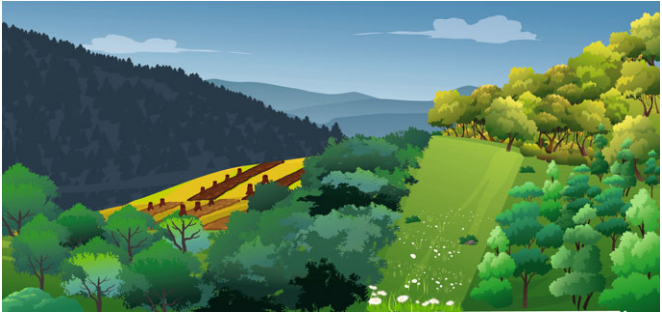
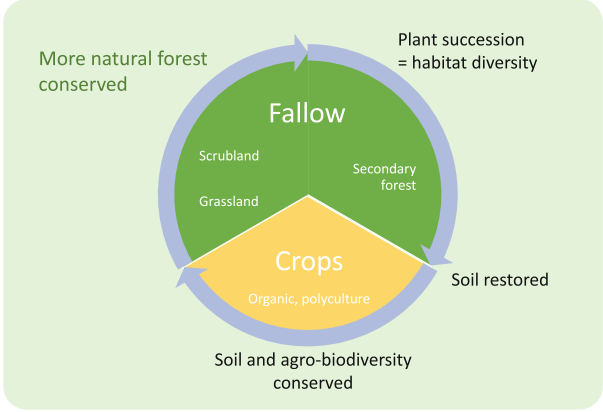
2 TRA as a Form of Ecosystem Restoration and Factors that Threaten It
Contrary to popular misconceptions, areas under TRA help the world to mitigate climate change (Bruun et al. 2009) whilst meeting crucial food demands and providing a diversity of habitats for biodiversity conservation (Finegan and Nasi 2004; Rerkasem et al. 2009). Our ecological knowledge allows us to develop the following model, which illustrates ecological succession using carbon stock as a surrogate, in shifting cultivation cycles under different fallow periods (Fig. 7.3). Plants and trees sequester carbon dioxide and store it in the ecosystem at varying rates depending on the age of fallows (Gogoi et al. 2020). In the optimal TRA cycle (represented by the blue curve in Fig. 7.3; Type A in Table 7.1), the carbon stock in the ecosystem returns to pre-existing levels at the end of the fallow period. As farmers cultivate different plots, they create landscape mosaics of different successional stages (Fig. 7.1). The longer the TRA cycle, the more variation in successional stages there will be in the TRA system, which is expected to support higher biodiversity. That is, at any given time, there will be plots of land located along the curve, representing habitat diversity resulting from different stages of ecological succession within the landscape. TRA therefore actively contributes to ecosystem restoration and enables conservation at the landscape level. This dual value of TRA for both biodiversity conservation and food production is rarely recognised.
When the TRA cycle is shortened (orange curve in Fig.7.3; Type B in Table 7.1), the average carbon stock across the TRA cycle (horizontal lines) declines. This occurs due to the shorter time available for the fallow plots to sequester carbon between cultivations, unless active measures are taken to accelerate carbon sequestration. The difference between the average carbon stocks (i.e. difference between the blue and orange horizontal lines) represents net carbon emissions resulting from the reduced cycles. In addition, the shorter fallow periods result in reduced productivity due to insufficient site recovery, which causes progressive reductions in carbon stock in subsequent cycles—this is expressed in the model by a 10% reduction in carbon stock recovery in each cycle.
An empirical study in Southeast Asia (Bruun et al. 2009) indicated that timeaveraged aboveground carbon stocks decline by about 90% when fallow periods are reduced to 4 years, and by about 60% if fallows are converted to oil palm plantations. Habitat diversity, too, is reduced under a shortened TRA cycle, due to reduced time for ecosystems to recover. Under these conditions, the default is adoption of more intensive land use of short fallows (i.e. Type B) or conversion to permanent farms. Type B could further result in the conversion of currently untouched forests to farmland to compensate for the reduced yield (due to the decreasing soil quality and reduced carbon stock of shorter cycles; Bruun et al. 2009).
Changing farming practices alter the nature of TRA, which creates modified suites of benefits and shortcomings (Table 7.1). The benefits of long fallow periods—the traditional practice—are mainly environmental, whilst the shortcomings are mainly social and economic. Shortening the fallow period, which is a common way of addressing these shortcomings, potentially leads to ecosystem degradation. Below, we describe traditional practices that can help avoid the unproductive consequences of a short fallow period by aiding forest recovery.
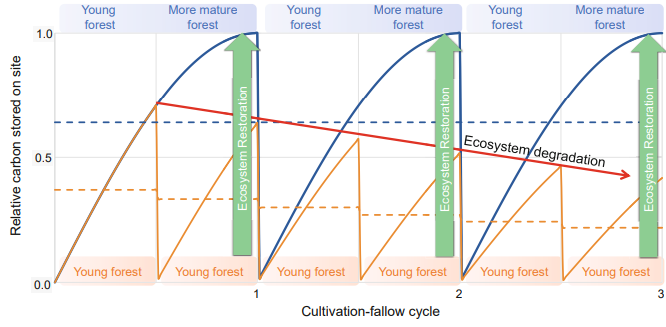
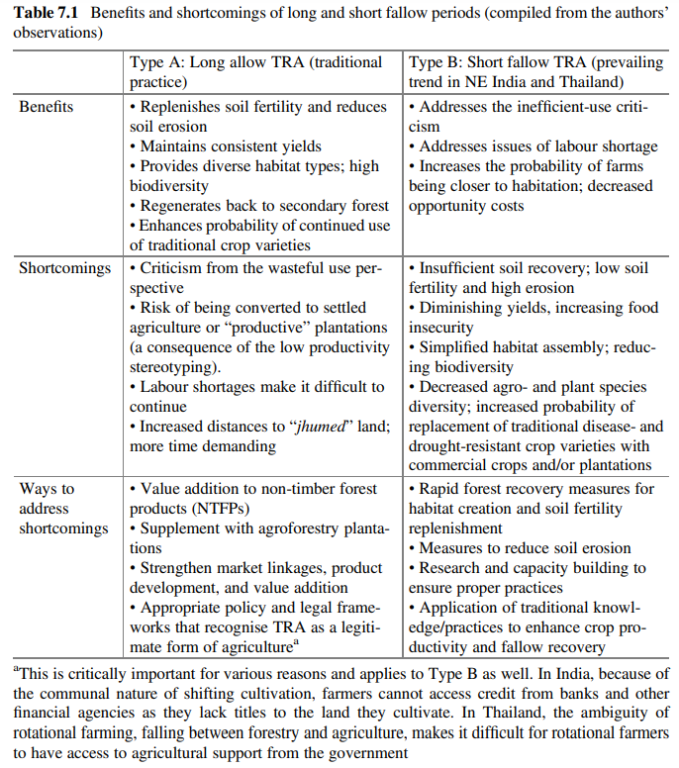
3 Traditional Techniques for Rapid Forest Recovery in Short Fallow Cultivation Cycles
The shortening of shifting cultivation cycles is increasingly the norm in Northeast India and Northern Thailand. Though reasons vary from one site to another (see below), there is a shared concern for the negative consequences of deviating from traditions. At the same time, both countries face pressure to adopt alternative, permanent cropping systems (Maithani 2005) and/or to convert to oil palm (Srinivasan 2014) and other tree plantations. Here, we review two cases where indigenous communities use their traditional knowledge to speed up forest recovery after cultivation. These two cases may provide valuable insights for other sites facing similar challenges.
3.1 Nagaland, India
Nagaland is a state in Northeast India (Fig. 7.4, Table 7.2). It is located in one of the most biodiverse regions of the world, where the Himalayas and Indo-Burma Biodiversity Hotspots meet. In Nagaland, high forest cover coexists with shifting cultivation (jhum). Although the Indian government has been promoting sedentary farming, particularly since jhum is viewed as a major cause of deforestation in Northeast India, jhum persists as the farming practice most suited to the topography and cultural sensitivities of the region. However, the length of the fallow period has decreased in Nagaland. Conversion to oil palm plantations—in search of economic returns—is an emerging and eminent threat as conversion often comes at the expense of environmental and cultural values (e.g. Pant et al. 2018 and references therein).
The increased food demand due to population increase in villages,2 possibly along with recent shortages of labour due to out-migration, has progressively shortened the fallow period in Nagaland from the traditional 15–20 or more years to 10–12 years in the late nineteenth century,3 and as low as 5–10 years (average of 9) today (Hutton 1921; Ramakrishnan 1992; Cairns et al. 2007; Rathore et al. 2010; NEPED and IIRR 1999). This trend poses a threat to the environmental sustainability (Ramakrishnan, 1992; Bruun et al. 2009) of the traditional system.
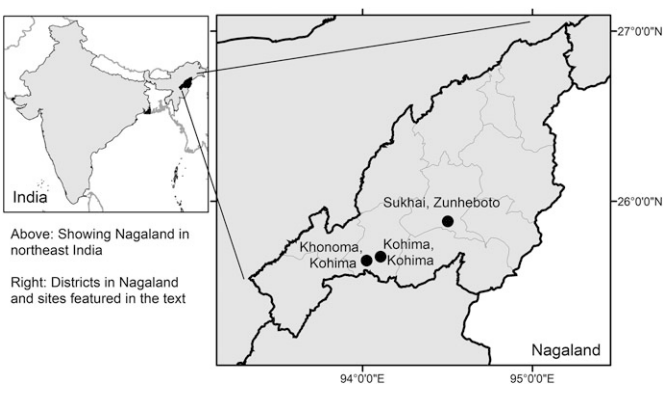
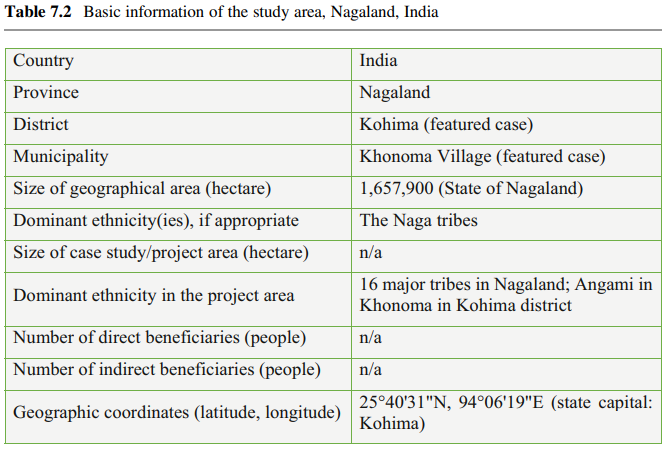
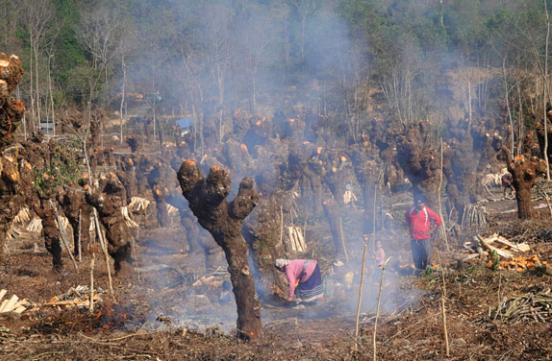
Despite the shortcomings of shifting cultivation with short fallow periods, highly sophisticated indigenous practices exist that circumvent issues of reduced fertility or enhanced soil erosion. The Angami community members of Khonoma village in Kohima district, Nagaland, for example practice a traditional agroforestry system based on the Nepalese alder (Alnus nepalensis) believed to be at least 500 years old (Cairns 2007) (Fig. 7.5). The alder is a deciduous or semi-deciduous, pioneer species that grows naturally throughout the Himalayas. Symbiotic actinomycetes Frankia on the root nodules help this tree species to fix nitrogen and improve soil fertility.
The indigenous tribes of Nagaland likely developed the alder system of jhum through astute observation and natural experimentation (Kehie et al. 2017). Representatives of Khonoma village explained their traditional practices to this chapter’s authors during site visits in January 2021 and August 2022.
In each shifting cultivation cycle, the Angami farmers in Khonoma village do not fell the alder trees but only prune 2–2.5 m from the ground. Crops are intercropped with the alder trees. There is no standard rule regarding spacing of alder trees, although about 6 m is common (Gokhale et al. 1985). Pollarded stumps are covered with mud/straw to prevent drying, and stone slabs are placed over them to allow the uniform sprouting of new shoots (Cairns et al. 2007). Farmers prune the alders in November and December. Amongst the resprouting stems, only the most vigorous stems are kept, with others removed the following August. Pollarding is reported to provide a silvicultural benefit of stimulating the growth of alder trees, and might even prolong their longevity (Cairn et al. 2007). Some trees in Khonoma are 150–200 years old, whilst the same tree species is considered a short-lived species (Lamichhaney 1995) in Nepal.
The area under jhum would be divided into five units. Each would be cultivated for 2 years and they would return to the original patch after 10 years (Meyase, pers.comm.). In the first year, upland rice is planted in warmer areas and Job’s tears (Coix lacryma-jobi) in cooler areas, frequently interplanted along with garlic, beans, chillies, cucurbits, and taro as secondary crops. Crops are harvested from October to November, and cattle are allowed to graze. Maize and pearl millet are grown during the second year. Following this, the lands are left fallow to regenerate from August onwards during which time they provide fuelwood, fix nitrogen, and accumulate soil organic matter (Cairns et al. 2007). The farmers may also divide their lands into 10 small plots. After a year, they shift to the next plot to cultivate, returning to the original plot after 10 years.
To prepare a field for cultivation, shrubs, and grasses are cut. Next, the alder tree branches are felled and collected for firewood and timber. Small branches and leaves are left to dry along with shrubs and grass. Once dry, the farmers burn them. The farmers also leave the dry leaves of the alder tree, which decompose and fertilise the soil. The alder trees start regrowing naturally. The farmers do not cultivate the forests on the top of the hillsides, which harbour water sources. Instead, jhum is practiced only on lower slopes.
The jhum farmers in Khonoma cultivate smaller areas, and hence labour shortage is not an issue. An important product derived from alder-based jhum is firewood and poles. The farmers, therefore, concentrate more on collecting firewood than cultivating agricultural products in jhum fields. This is also possibly due to the high productivity of wet terraced rice that is grown in the valley bottoms in addition to jhum. The farmers do not use machines, as they feel that the use of chainsaws could hinder the regrowth of the alder trees. Hence, they prefer to use axes to cut the branches. The jhum farmers grow a variety of crops like maize, cabbage, potatoes, and chillies. Potatoes are sold at a price rate of INR 50/kg (USD 0.67 on 2022/1/17). Chillies and maize are cultivated for self-consumption, but some maize is used for chicken feed. The farmers say they have not seen any decreases in productivity.
The farmers of Khonoma have an innovative way of preventing soil erosion. Their terraced jhum fields do not have barriers to hold the soil. Instead, the paddy fields are located right below the terraced farms, so that the rain washes the soil directly into the paddy fields below. The horizontal spreading root systems of the alder tree also help to stabilise the slopes and reduce soil erosion. In Khonoma, another N-fixing species, Albizia stipulata, is planted to enhance the fertility of wet rice cultivation (Cairns 2007). The Angamis of Khonoma practice a highly sophisticated, intensified system of TRA with several unique facets that are not commonly observed in other places where jhum is practiced.4
Jhum lands in Nagaland exhibit exceptionally high levels of agro-biodiversity. Chetehba village in Phek district has 167 types of crops, including 12 rice varieties. In the Wokha district, 18 residual crops remain in the fields after the main crops are harvested (NEPED and IIRR 1999). At a three-day farmer’s market in September 2021, 66 varieties of vegetables and fruits were brought for sale from nine villages in Zunheboto District (TERI, unpublished data).
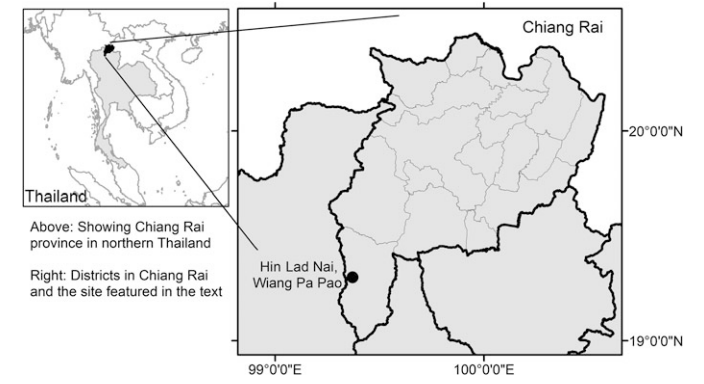
2 The population of Nagaland increased by 64.41% between 1991 and 2001 as compared to the all-India average of 21.34% per the Census of India in 2001, although the accuracy of some of the census figures have been questioned (Agrawal and Kumar 2012). Nagaland is the only state in India which saw an increase in area under jhum between 2005–2006 and 2015–2016 (NRSC & DOLR, 2005–2015).
3 Even a hundred years ago, regional variation existed. Hutton (1921, p. 59) has this to say about the length of the cycle in what is now Zunheboto district, Nagaland: “In the Tizü valley, however, and in parts of Kileki valley where the population has much outgrown the supply of suitable jhuming land, jhums may often be found cleared after only five years’ rest, and in some villages even after three, while loads of earth have to be sometimes actually carried and dumped down in the rocky parts of the field to make sowing possible at all.”
4 For example, the creation of terraces for jhum is not a common practice in shifting cultivation, nor is the presence of stone walls. While 10-year cycles are followed possibly because of the resulting pole yield, a 4-year total cycle is reportedly effective at regenerating jhum fallows (see Cairns 2007).
3.2 Chiang Rai, Thailand
The Karen people of Northern Thailand refer to shifting cultivation as Baa muan wiang, literally “rotating forests” (Cairns et al. 2007), or rai mun wian (“rotational farming”). The majority view of the state, and the public, however, is that rotational farming is detrimental to forests and biodiversity, associated with opium production, and practiced by people disloyal to the Thai nation, Buddhism, and the Thai monarchy. There are many cases of rotational farmers being arrested or forced to stop the practice due to direct and indirect pressure from the national government’s development agenda, and bilateral and multilateral development aid. The state encourages the growing of cash crops (such as cabbages, potatoes, and corn) in permanent farms with the use of chemical pesticides and herbicides. The consequences, however, are an increased impact on the environment, and financial hardship and health problems for farmers. For the purposes of this chapter, we highlight the traditional farming practices of the community of Hin Lad Nai in Chiang Rai Province in Northern Thailand (Fig. 7.6; Table 7.3).
There is, nevertheless, some level of acceptance in Thailand that rotational farming is a system that supports food security because a wide variety of traditional/local seeds and plants are grown. What has proven more difficult to convey is that the fallow forest is an integral—and important—part of the cultivation cycle. The authorities consider the long fallow period as a wasteful use of land, and rotational farmers are ineligible for the public support that other farmers ordinarily enjoy. To cope with this situation, rotational farmers are innovating ways to quickly regenerate soil fertility, to shorten the fallow period, and to increase the productivity of fallow land with non-timber forest products. Fallow land regenerates more quickly with species such as Macaranga denticulata (or p’dav in the Karen language). A shorter fallow period addresses the criticism of rotational farming as a wasteful land use, and faster re-establishment of a forest mitigates the shortcomings of Type B TRA discussed above.
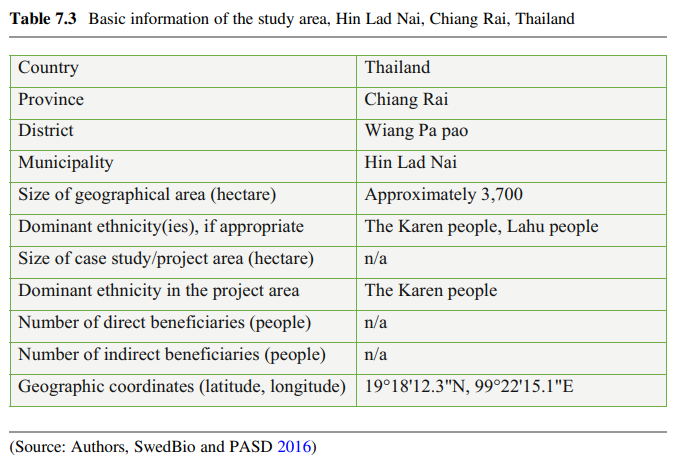
There is, nevertheless, some level of acceptance in Thailand that rotational farming is a system that supports food security because a wide variety of traditional/local seeds and plants are grown. What has proven more difficult to convey is that the fallow forest is an integral—and important—part of the cultivation cycle. The authorities consider the long fallow period as a wasteful use of land, and rotational farmers are ineligible for the public support that other farmers ordinarily enjoy. To cope with this situation, rotational farmers are innovating ways to quickly regenerate soil fertility, to shorten the fallow period, and to increase the productivity of fallow land with non-timber forest products. Fallow land regenerates more quickly with species such as Macaranga denticulata (or p’dav in the Karen language). A shorter fallow period addresses the criticism of rotational farming as a wasteful land use, and faster re-establishment of a forest mitigates the shortcomings of Type B TRA discussed above.
The p’dav grows in fallow forests (Fig. 7.7). The Karen people who traditionally use p’dav also know when the land is ready for another season of farming. A Karen poem says, “p’dav fallow grows up in a line along fallow land, why do you keep farming the old field?” Karen traditional knowledge contrasts two diverse ways of farming—one is opening the good fallow land for farming again, and another is continuing to cultivate the old cropland—and questions the use of unproductive old cropland when the p’dav trees presage the readiness of the fallow land to farm and obtain good yields. The p’dav is an indicator of the readiness of the fallow site for re-cultivation. Traditional rotational farming embodies a living culture where such invaluable knowledge on the best time to reclaim fallow land is passed down through generations via poems and songs.
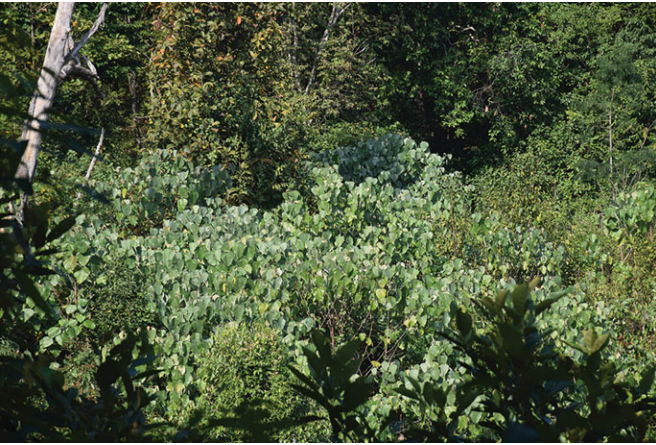
The p’dav is a tree species that has a soft trunk and branching roots that spread at shallow depths around the stump. It only propagates with seeds, which can be collected during August and September. Several varieties are known to local communities: 1) p’dav Caiv; 2) p’dav gauz hpo (red p’dav); 3) p’dav wa (white p’dav); and 4) p’dav loz loz (normal p’dav). Although it is easier to collect the seeds of red and white p’dav, the normal p’dav is better for regenerating soil.
The fallen leaves of p’dav trees keep the soil surface cool and hold rainwater, and decay quickly and thoroughly, becoming good, fertile soil. Accordingly, the soil of p’dav fallows becomes suitable for farming earlier (in 5–6 years) than that of normal fallows. Farmers know that the soil has improved if it is soft, black, and full of earthworms. The presence of holes made by wildlife, such as bamboo rats (genus Rhizomys), porcupines, and wasps, is another indication.
A farmer, Mr. Somboon Siri, compared fallow lands with p’dav (3 plots) and
without p’dav (3 plots) for 14 years (SwedBio and PASD 2016, pp. 9–11). His
observations suggest that the fallow lands with p’dav:
- Were more suited for cultivation.
- Had fewer grasses unfavourable to soil fertility, e.g. Nauf ne si, Nauf k’seij has, k’po hpo (local names).
- Had healthier plants and larger harvests of almost all crops (e.g. rice production increases)—for example, for 1 kg of rice seed input, 35 kg of rice was harvested after p’dav fallow vs. 30 kg after no-p’dav fallow.
- Had more reliable production under varying seasonal weather (dry or wet).
It is believed that shade created by the p’dav trees helps to control most of the grasses which make the soil poor for crop cultivation. Some of these grasses are considered weeds for rice and other plants in the rice field.
The p’dav produces large quantities of fruit, which attracts wildlife5 and aids dispersal and regeneration. The p’dav areas, therefore, become productive hunting and trapping grounds. Domesticated animals, e.g. buffaloes and cows, favour the p’dav fruit, making p’dav forests foraging areas for them as well.
Because the p’dav grows fast, and its big leaves shade the ground underneath, there is a possibility that the preferential use of the p’dav could decrease biodiversity in the fallow lands. Empirical studies are required to conclude the debate over the benefits and drawbacks of the use of p’dav.
In parallel, there is a discussion on whether it might be effective to use the p’dav for recovering impoverished soil after intensive cash crop cultivations. For instance, farmers could plant shade crops (e.g. coffee or tea) under p’dav. Also, in areas where people need firewood to cook, the p’dav could be helpful because its branches make good firewood, and the tree grows fast. Trees are good for firewood in just 2–3 years, and they are easy to dry, light to carry, and easy to cut into pieces to burn.
Other benefits of rotational farming include production of plant species for local consumption and potential income, e.g. Litsea cubeba (the lemongrass tree or s’luj saf in Karen) and Rhus chinensis (the Chinese sumac). Beekeeping in fallows contributes to both livelihoods (honey production and pollinating crops) and biodiversity conservation. Tree cover in fallows provides habitats for wildlife species. Older fallow forests (7 years and older) have abundant vines, which are used for herbal medicine and handicrafts. Thus, fallow land is hardly “wasteland”.
5 Examples include: • Birds: htof bau lauv (red-whiskered bulbul, Pycnonotus jocosus), htof bau hpo, bif bei (minivets, Pericrocotus spp.), wild chicken, htof bgef (Siamese partridge, Arborophila diversa), htof giv (pheasants), and at least five different species of dove (htof lwij bu [rice dove], htof lwij gauz [red dove], htof lwij htau maij [long-tail dove], htof lwij qei [dry dove], htof lwij hkaf [bitter dove]); direct translation of local names). • Rats and squirrels: Liv lai, yuj lai, liv bau hkaf, liv looj gauz sav, yuj qoov yuj gauz, yuj hko. • Taj hpo nyau (the palm civet). • Bees: kwaiv dof (eastern honey bee, Apis cerana), kwaiv hpo (meliponines), de t’yoo (dwarf honey bee, Apis florea) etc.
4 Discussion
The area that is cultivated in any given year is a “unit”, and there are several of these units under a TRA system; the number of units corresponds approximately to the number of years of the TRA cycle. Ecosystems within individual units are cleared and burned, which is the source of the commonly held conception that TRA is harmful to biodiversity. However, TRA should be considered in a more macro view—at the level of a landscape rather than in terms of each “unit”. At the landscape level, a range of different but interacting ecosystems and land uses are supported, including mixed crop fields, pasturelands, regenerating forests of varied ages, and primary or old successional forests. This landscape-level system is buttressed with other land uses, particularly home gardens and rice cultivation in the valleys. Furthermore, human use, or anthropogenic disturbance, is contained within the TRA system, and surrounding forest is kept intact whilst farming is rotated across fixed patches—where and how farming has been practiced traditionally.
As the economic and demographic circumstances, as well as the political discourses on TRA, change, the practice of TRA needs to adapt to maintain benefits and minimise shortcomings (Table 7.1). Below, we discuss the future of TRA from environmental and socio-economic perspectives, as they relate to ecosystem restoration.
4.1 Environmental Perspectives
A long fallow period as traditionally practiced has the environmental benefits of: (1) storing more carbon, an important function forests play in mitigating climate change; (2) providing diverse habitat types at different stages of ecological succession (Fig. 7.3) with higher biodiversity than both short fallows (e.g. Wang and Young 2003) or alternative land uses such as palm oil and teak plantations (e.g. Mandal and Raman 2016); (3) harbouring high levels of agro-biodiversity through cultivation of locally adapted, traditional crop varieties (e.g. Rerkasem et al. 2009; Amba Jamir, pers. comm.); (4) controlling weed growth and regenerating soil fertility from biomass accumulation and nutrient cycling (e.g. Teegalapalli et al. 2018); and (5) regulating water flows and soil erosion (e.g. Ziegler et al. 2009), amongst others. Moreover, paleoecological research suggests that shifting cultivation systems of varied fallow lengths enhance both landscape-scale biodiversity and the resilience of forests to climate shifts (Hamilton et al. 2020), and have played a role in shaping some of the most biodiverse regions of the planet (Fletcher et al.
2021).
The two cases presented above demonstrate that the use of traditional practices allows for many environmental benefits, even with short fallow cycles. The contribution of TRA to the economic and livelihood security of upland communities is undeniable, as are contributions to forest cover maintenance. Effective and productive uses of short fallow periods based on the economic, ecological, and cultural requirements of the local people, ranging from agroforestry plantations to the alder, p’dav, and similar management practices, are beneficial, especially considering the close cultural affinities with traditional practices.
Although the p’dav and the alder are featured here, there are many other species that can be used to regenerate fertility during the fallow phase. This model of ecosystem restoration can be replicated elsewhere by identifying and using species suited to the area of interest. Moreover, the use of intelligent design principles—e.g. practices like leaving hilltop forests untouched as water catchments; situating cultivated fields close to primary or late-successional forests to facilitate nutrient and water flows, seed dispersal, and pollination (Teegalapalli et al. 2009); interspersing community-conserved areas; and regulating hunting of wildlife that aid in forest recovery—will ensure both ecosystem restoration and food security.
Raising pollinators for honey and pollination services can address conservation challenges in TRA in multiple ways. As briefly mentioned in the discussion of Hin Lad Nai, beekeeping in fallow lands is an innovation that directly and indirectly supports biodiversity. Bees pollinate plants in the fallow land, and in forests and grasslands around the fallow lands, benefiting the entire ecosystem. Besides the important function of pollination, bees also produce honey for consumption and income for the farmers. Since bee boxes are kept in the fallow lands, beekeeping also motivates farmers to take care of their fallow lands and forest areas. By keeping bees, the local farmers take care of the whole ecosystem, simultaneously securing their food supply and income from non-timber forest products (NTFPs).
4.2 Socio-Economic Perspectives
Despite pressures to eliminate shifting cultivation, the practice continues to be wellentrenched in both Northeast India (e.g. Pandey et al. 2020) and in Northern Thailand. Almost 90% of a sample of Adi families interviewed in central Arunachal Pradesh, India, continue to practice shifting cultivation despite the introduction of settled cultivation in the 1960s Teegalapalli and Datta 2016). A recent study of 52 northeastern villages in India (Pandey et al. 2020) found that shifting cultivation continued to be communities’ preferred mode of cultivation primarily because of shared communal ties and traditions (social bonding), and their dependence on jhum as a means of livelihood rooted in their remote mountainous homes in the absence of other viable alternatives (Sarma 2022; Bhattacharjee 2022) for food production.
Jhum systems interwoven with the elaborate social and cultural traditions of tribal communities provide food safety nets for poorer households. Amongst the Sümi, Konyak, and Chang tribes of Nagaland, the chief who owns most of the land decides who gets a piece of land to farm based on the needs of each member of the village community. This and other highly divergent tribal land ownership systems ensure that all members of the village community have land to cultivate and people are not left “landless”. Shifts to more permanent cropping systems owned and managed by individuals have negative impacts on the socio-economic security of jhum cultivators, and on community decision-making for sustainable land management (e.g. Das 2020). These shifts might also impact the range of products and services that the landscapes provide (such as water, NTFPs, wildlife to hunt, timber, fuel, and crop diversity), decreasing the resilience of these socio-ecological production landscapes and their regenerative capacity.
Transitions to settled cultivation are also likely to undermine the role that women play in protecting agro-biodiversity, and eventually the influence they wield in ensuring crop resilience. Women were traditionally in charge of seed management and exchange, carrying seeds between their natal and marital villages (Goodrich 2012). Altering TRA practices could therefore have unforeseen effects in multiple dimensions.
4.3 Opportunities and Challenges
TRA can be improved and adapted to changing circumstances. Because TRA uses the regenerative function of natural systems, aspects of ecosystem restoration are built into the traditional practices. Since both Macaranga denticulata and Alnus nepalensis are common species in the region, opportunities to replicate the practices of communities in Hin Lad Nai and Khonoma villages would be possible with some effective outreach and extension activities. A programme to support farmer-tofarmer information exchange, such as exposure visits, could facilitate such capacity building.
TRA can also employ established innovations in ecosystem restoration during both cultivation and fallow periods to better cope with environmental and economic challenges. Examples include soil conservation measures, reforestation of fallow plots combined with agroforestry, and assisted forest regeneration with strategically selected tree species. As highlighted in the Hin Lad Nai case, NTFPs such as honey can contribute positively not only to the livelihoods of the farmers, but also to the care of forests in fallow periods. A win-win relationship can be created between environmental and economic concerns by focusing on the productive management of fallow forests. Despite the foreseeable benefits, initial investments to put new activities into motion, as well as motivating farmers to take on new activities, continue to pose challenges.
5. Conclusion
In conclusion, TRA is dynamic and many solutions exist for the rapid regeneration of short fallows, but all must be based on traditional knowledge, practices, and philosophy. TRA, consisting of cycles of cultivation and fallow periods, is an expression of indigenous self-sufficiency and sustainable natural resource management. The cultural, social, and religious fabric of tribal communities in Northeast India and Northern Thailand is intricately connected to this practice of land use. Most of the traditional festivals correspond to various stages of cultivation. The rejection of TRA in favour of settled cultivation and/or plantations could therefore undermine traditional social cohesion with possible negative impacts on the socialecological resilience of these forest-farm landscapes. Ancient wise-use taboos, along with indigenous and local knowledge and practices (ILKPs), contributed to environmental sustainability in the past, but are eroding today. The diminution of social cohesion and traditional knowledge held amongst the community members leads to the loss of knowledge that can inform ecosystem restoration. Reviving where appropriate, and learning from these ILKPs (e.g. alder management of the Angamis or p’dav of the Karen people), contributes to ensuring (sensu Dasgupta et al. 2021) that sustainable environmental boundary conditions persist.
AcknowledgementsThe documentation of activities in Khonoma village in India was supported by a grant from the Japan Fund for Global Environment. We thank various people, particularly Mr. Amba Jamir, Dr. Anirban Datta-Roy, and Mr. Angulie Meyase, for sharing their knowledge and providing several important references for this chapter
References
Agrawal A, Kumar V (2012) An investigation into changes in Nagaland’s population between 1971 and 2011. In: IEG Working paper No. 312. Institute of Economic Growth, University of Delhi, New Delhi
Bruun TB, de Neergaard A, Lawrence D, Ziegler AD (2009) Environmental consequences of the demise in Swidden cultivation in Southeast Asia: carbon storage and soil quality. Hum Ecol 37: 375–388
Bhattacharjee S (2022) Re-assessing Jhum in Arunachal Pradesh: colonial perceptions, indigenous environmental practices and post-colonial transitions. In: Shaw AK, Natori Y, Edake S (eds) A tradition in transition: understanding the role of shifting cultivation for sustainable development of north East India. TERI Press, New Delhi, pp 106–125
Borah D, Goswami NR (1973) A comparative study of crop production under shifting and terrace cultivation: a case study in Garo hills, Meghalaya. Ad hoc Study No. 35. Agro-economic Research Centre for North East India, Assam Agricultural University, India
Cairns M (2007) The alder managers: the cultural ecology of a village in Nagaland, N.E. India. Ph.D. thesis, Australian National University, Canberra
Cairns M, Brookfield H (2011) Composite farming systems in an era of change: Nagaland, Northeast India. Asia Pac Viewp 52:56–84. https://doi.org/10.1111/j.1467-8373.2010.01435.x
Cairns M, Keitzar S, Yaden TA (2007) Shifting forests in Northeast India. Management of Alnus nepalensis as an improved fallow in Nagaland. In: Cairns M (ed) Voices from the Forest: integrating indigenous knowledge into sustainable upland farming. Resources for the Future, New York, pp 341–378
Das D (2020) Modernity lacks care: community-based development and the moral economy of households in eastern Nagaland. J South Asian Dev 15:97–116
Dasgupta R, Dhyani S, Basu M, Kadaverugu R, Hashimoto S, Kumar P, Johnson BA, Takahashi Y, Mitra BK, Avtar R, Mitra P (2021) Exploring indigenous and local knowledge and practices (ILKPs) in traditional jhum cultivation for localizing sustainable development goals (SDGs): a case study from Zunheboto district of Nagaland, India. Environ Manag:1. https://doi.org/10.1007/s00267-021-01514-6
Finegan B, Nasi R (2004) The biodiversity and conservation potential of shifting cultivation landscapes in tropical landscapes. In: Schroth G, da Fonseca GAB, Harvey CA, Gascon C, Lasconcelos HL, Izac A-MN (eds) Agroforestry and biodiversity conservation in tropical landscapes. Island Press, Washington, DC, pp 153–197
Fletcher MS, Hamilton R, Dressler W, Palmer L (2021) Indigenous knowledge and the shackles of wilderness. Proc Natl Acad Sci U S A 118(40):1–7
Gogoi A, Sahoo UK, Saikia H (2020) Vegetation and ecosystem carbon recovery following shifting cultivation in Mizoram-Manipur-Kachin rainforest eco-region, Southern Asia. Ecol Proc 9:1. https://doi.org/10.1186/s13717-020-00225-w
Gokhale AM, Zeliang DK, Kevichusa R, Angami T, Bendangnungsang S (1985) The use of alder trees. State Council of Educational Research and Training, Education Department, Government of Nagaland, Kohima
Goodrich GC (2012) Gender dynamics in agro-biodiversity conservation in Sikkim and Nagaland. In: Krishna S (ed) Agriculture and a changing environment: perspectives on northeastern India. Routledge, New Delhi
Hamilton R, Penny D, Hall TL (2020) Forest, fire & monsoon: investigating the long-term threshold dynamics of south-East Asia’s seasonally dry tropical forests. Quatenary Science Reviews 238: 106334. https://doi.org/10.1016/j.quascirev.2020.106334
Hutton JH (1921) The Sema Nagas. MacMillan and Co. Ltd., London
Kehie M, Khamu S, Kehie P (2017) Indigenous alder based farming practices in Nagaland, India. J Traditional Folk Pract 5(2):82–152
Lamichhaney BP (1995) Alnus nepalensis D. Don: A detailed study. In FORESC Monograph 1, Forest Research and Survey Centre, Ministry of Forests and Soil Conservation, Kathmandu
Mandal J, Raman TRS (2016) Shifting agriculture supports more tropical forest birds than oil palm or teak plantations in Mizoram, Northeast India. Condor 118:345–359. https://doi.org/10.1650/CONDOR-15-163.1
Maithani BP (2005) Shifting cultivation in north-East India: policy issues and options, Mittal Publications, New Delhi, viewed 10 February 2022. Retrieved from https://books.google.co.jp/books?printsec=frontcover&vid=LCCN2005322020&redir_esc=y#v=onepage&q&f=false
Meena V (2018) GIS file of India State, District and Tehsil Boundaries, map, ArcGIS Hub, accessed on 31 August 2021. Retrieved from https://hub.arcgis.com/content/cba8bddfa0ab43ddb35a7313376f9438/
NEPED & IIRR (1999) Building upon traditional agriculture in Nagaland, India. Nagaland Environment Protection and Economic Development & International Institute of Rural Reconstruction, Silang
NRSC & DOLR (2005–2019) Wasteland atlas of India, National Remote Sensing Centre, Indian Space Research Organisation, Department of Space Hyderabad and Department of Land Resources, Ministry of Rural Development, Government of India, New Delhi, viewed 4 February 2022. Retrieved from https://dolr.gov.in/documents/wasteland-atlas-of-india
Pandey DK, De HK, Dubey SK, Kumar B, Dobhal S, Adhiguru P (2020) Indigenous people’s attachment to shifting cultivation in the eastern Himalayas, India: a cross-sectional evidence. Forest Policy Econ 111:102046. https://doi.org/10.1016/j.forpol.2019.102046
Pant PM, Panchayati R, Tiwari BK, Choudhury D (2018) Shifting cultivation: towards a transformational approach. Report of Working Group III, NITI Aayog, New Delhi, viewed 4 February 2022. Retrieved from https://lib.icimod.org/record/34338
Ramakrishnan PS (1992) Shifting agriculture and sustainable development: an interdisciplinary study from North-Eastern India. MAB Series, vol. 10. UNESCO, Paris
Ranjan R, Upadhyay VP (1999) Ecological problems due to shifting cultivation. Curr Sci 77:1246
Rathore SS, Karunakaran K, Prakash B (2010) Alder based farming system a traditional farming practices in Nagaland for amelioration of jhum land. Indian J Tradit Knowl 4:677–680
Rerkasem K, Lawrence D, Padoch C, Schmidt-Vogt D, Ziegler AD, Bruun TB (2009) Consequences of swidden transitions for crop and fallow biodiversity in Southeast Asia. Hum Ecol 37: 347–360
Royal Thai Survey Department (2019) Thailand (THA) Administrative Boundary Common Operational Database, map, Humanitarian Data Exchange, viewed 19 February 2022. Retrieved from https://data.humdata.org/dataset/cod-ab-tha
Sarma A (2022) Can shifting cultivation ensure local food sovereignty? In: Edake S (ed) A tradition in transition: understanding the role of shifting cultivation for sustainable development of north East India. TERI Press, New Delhi
Srinivasan U (2014) Oil palm expansion: ecological threat to north-East India. Econ Political Weekly, 49(36), viewed 10 February 2022. Retrieved from http://www.epw.in/journal/2014/36/reports-states-web-exclusives/oil-palm-expansion.html
SwedBio & PASD (2016) Mobilizing Traditional Knowledge, Innovations and Practices in rotational farming for sustainable development, SwedBio at Stockholm Resilience Centre and Pgaz K’ Nyau Association for Sustainable Development, viewed 10 February 2022. Retrieved from https://swed.bio/wp-content/uploads/2016/11/MEB-Pilot-Report-Thailand_2016.pdf
Teegalapalli K, Datta A (2016) Shifting to settled cultivation: changing practices among the Adis in Central Arunachal Pradesh, north-East India. Ambio 45:602–612. https://doi.org/10.1007/s13280-016-0765-x
Teegalapalli K, Veeraswami GG, Samal PK (2009) Forest recovery following shifting cultivation: an overview of existing research. Trop Conserv Sci 2:374–387
Teegalapalli K, Mailappa AS, Lyngdoh N, Lawrence D (2018) Recovery of soil macronutrients following shifting cultivation and ethnopedology of the Adi community in the eastern Himalaya. Soil Use Manag 34:249–257
Wang Z, Young SS (2003) Differences in bird diversity between two swidden agricultural sites in mountainous terrain, Xishuangbanna, Yunnan, China. Biol Conserv 110:231–243. https://doi.org/10.1016/S0006-3207(02)00222-7
Ziegler AD, Bruun TB, Guardiola-Claramonte M, Giambelluca TW, Lawrence D, Lam NT (2009) Environmental consequences of the demise in Swidden cultivation in montane mainland Southeast Asia: hydrology and geomorphology. Hum Ecol 37:361–373. https://doi.org/10.1007/s10745-009-9258-x
Note
The opinions expressed in this chapter are those of the author(s) and do not necessarily reflect the views of UNU-IAS, its Board of Directors, or the countries they represent.
Open Access This chapter is licenced under the terms of the Creative Commons AttributionNonCommercial-ShareAlike 3.0 IGO licence (http://creativecommons.org/licenses/by-nc-sa/3.0/ igo/), which permits any noncommercial use, sharing, adaptation, distribution and reproduction in any medium or format, as long as you give appropriate credit to UNU-IAS, provide a link to the Creative Commons licence and indicate if changes were made. If you remix, transform, or build upon this book or a part thereof, you must distribute your contributions under the same licence as the original. The use of the UNU-IAS name and logo, shall be subject to a separate written licence agreement between UNU-IAS and the user and is not authorised as part of this CC BY-NC-SA 3.0 IGO licence. Note that the link provided above includes additional terms and conditions of the licence.
The images or other third party material in this chapter are included in the chapter’s Creative Commons licence, unless indicated otherwise in a credit line to the material. If material is not included in the chapter’s Creative Commons licence and your intended use is not permitted by statutory regulation or exceeds the permitted use, you will need to obtain permission directly from
the copyright holder.

